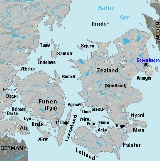
Omø
Encyclopedia
Omø is a Danish
island
in the Great Belt
. The island covers an area of 4.52 km² (1.7 sq mi), with a 12-kilometre (7-mile) coastline, and has 168 inhabitants, of which the majority inhabit Omø village, which has a church, and Kirkehavn, a small harbour with a ferry boat berth, along with a newly built marina, made for the purpose of promoting fishery
, which, along with agriculture
, conforms the island's main economic activity. Some of the island's natural features are its lake and its bog
; also, it is characterized for its varied bird
life.
Omø maintains a lighthouse
and cabins, along with a campsite, in order to invite tourism
.

Denmark
Denmark is a Scandinavian country in Northern Europe. The countries of Denmark and Greenland, as well as the Faroe Islands, constitute the Kingdom of Denmark . It is the southernmost of the Nordic countries, southwest of Sweden and south of Norway, and bordered to the south by Germany. Denmark...
island
Island
An island or isle is any piece of sub-continental land that is surrounded by water. Very small islands such as emergent land features on atolls can be called islets, cays or keys. An island in a river or lake may be called an eyot , or holm...
in the Great Belt
Great Belt
The Great Belt is a strait between the main Danish islands of Zealand and Funen . Effectively dividing Denmark in two, the Belt was served by the Great Belt ferries from the late 19th century until the islands were connected by the Great Belt Fixed Link in 1997–98.-Geography:The Great Belt is the...
. The island covers an area of 4.52 km² (1.7 sq mi), with a 12-kilometre (7-mile) coastline, and has 168 inhabitants, of which the majority inhabit Omø village, which has a church, and Kirkehavn, a small harbour with a ferry boat berth, along with a newly built marina, made for the purpose of promoting fishery
Fishery
Generally, a fishery is an entity engaged in raising or harvesting fish which is determined by some authority to be a fishery. According to the FAO, a fishery is typically defined in terms of the "people involved, species or type of fish, area of water or seabed, method of fishing, class of boats,...
, which, along with agriculture
Agriculture
Agriculture is the cultivation of animals, plants, fungi and other life forms for food, fiber, and other products used to sustain life. Agriculture was the key implement in the rise of sedentary human civilization, whereby farming of domesticated species created food surpluses that nurtured the...
, conforms the island's main economic activity. Some of the island's natural features are its lake and its bog
Bog
A bog, quagmire or mire is a wetland that accumulates acidic peat, a deposit of dead plant material—often mosses or, in Arctic climates, lichens....
; also, it is characterized for its varied bird
Bird
Birds are feathered, winged, bipedal, endothermic , egg-laying, vertebrate animals. Around 10,000 living species and 188 families makes them the most speciose class of tetrapod vertebrates. They inhabit ecosystems across the globe, from the Arctic to the Antarctic. Extant birds range in size from...
life.
Omø maintains a lighthouse
Lighthouse
A lighthouse is a tower, building, or other type of structure designed to emit light from a system of lamps and lenses or, in older times, from a fire, and used as an aid to navigation for maritime pilots at sea or on inland waterways....
and cabins, along with a campsite, in order to invite tourism
Tourism
Tourism is travel for recreational, leisure or business purposes. The World Tourism Organization defines tourists as people "traveling to and staying in places outside their usual environment for not more than one consecutive year for leisure, business and other purposes".Tourism has become a...
.

See also
- Nearby islands: Zealand, AgersøAgersøAgersø is a Danish island in the Great Belt close to Zealand. The island covers an area of 6.84 km² and has 233 inhabitants .-See also:* Nearby islands: Sjælland, Omø, Funen, Langeland, Vejrø, Fejø, Femø, Lolland....
, Glaenø, VejrøVejrøVejrø is a Danish island north of Lolland. It covers an area of 1.57 km² and has two inhabitants .The island is private property; for tourists, it offers a marina, an airfield, and some cottages for rent.-External links:*...
, FejøFejøFejø is a Danish island north of Lolland. It covers an area of and has 611 inhabitants . Fejø has two villages: Vesterby and Østerby...
, FemøFemøFemø is a Danish island north of Lolland. The island covers an area of 11.38 km². Femø has 154 inhabitants .-Women's camp:Every year since 1971 women have met and spent their holiday together in the north-east corner of the island...
, LollandLollandLolland is the fourth largest island of Denmark, with an area of 1,243 square kilometers . Located in the Baltic sea, it is part of Region Sjælland...
. - Nearby cities: KorsørKorsørKorsør is a Danish town and port. It is out on the Great Belt, on the Zealand side, just south of where the Great Belt Bridge lands. It was the site of the municipal council of Korsør municipality - today it is part of Slagelse municipality...
, SkælskørSkælskørSkælskør is a town in Slagelse municipality on the Danish island of Zealand. The town has a population of 6,358 . Administratively, the town is in Region Sjælland and is home to one of Denmark's largest breweries, the Harboe Brewery....
, SlagelseSlagelseSlagelse, a town in east Denmark, is in Slagelse municipality on the island of Zealand. It is about 100 km southwest of Copenhagen. The population is 31,979 ....
, Næstved.

